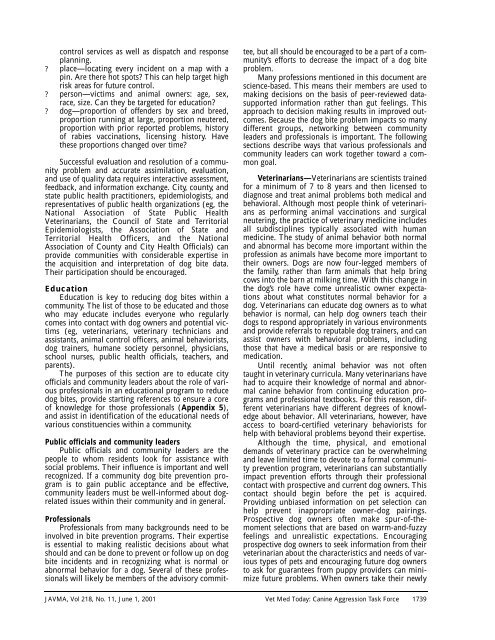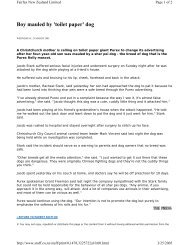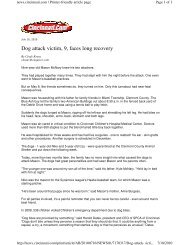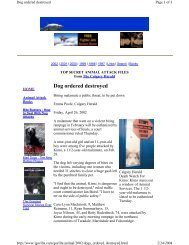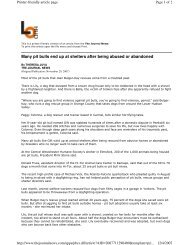A community approach to dog bite prevention - American Veterinary ...
A community approach to dog bite prevention - American Veterinary ...
A community approach to dog bite prevention - American Veterinary ...
You also want an ePaper? Increase the reach of your titles
YUMPU automatically turns print PDFs into web optimized ePapers that Google loves.
control services as well as dispatch and response<br />
planning.<br />
? place—locating every incident on a map with a<br />
pin. Are there hot spots? This can help target high<br />
risk areas for future control.<br />
? person—victims and animal owners: age, sex,<br />
race, size. Can they be targeted for education?<br />
? <strong>dog</strong>—proportion of offenders by sex and breed,<br />
proportion running at large, proportion neutered,<br />
proportion with prior reported problems, his<strong>to</strong>ry<br />
of rabies vaccinations, licensing his<strong>to</strong>ry. Have<br />
these proportions changed over time?<br />
Successful evaluation and resolution of a <strong>community</strong><br />
problem and accurate assimilation, evaluation,<br />
and use of quality data requires interactive assessment,<br />
feedback, and information exchange. City, county, and<br />
state public health practitioners, epidemiologists, and<br />
representatives of public health organizations (eg, the<br />
National Association of State Public Health<br />
Veterinarians, the Council of State and Terri<strong>to</strong>rial<br />
Epidemiologists, the Association of State and<br />
Terri<strong>to</strong>rial Health Officers, and the National<br />
Association of County and City Health Officials) can<br />
provide communities with considerable expertise in<br />
the acquisition and interpretation of <strong>dog</strong> <strong>bite</strong> data.<br />
Their participation should be encouraged.<br />
Education<br />
Education is key <strong>to</strong> reducing <strong>dog</strong> <strong>bite</strong>s within a<br />
<strong>community</strong>. The list of those <strong>to</strong> be educated and those<br />
who may educate includes everyone who regularly<br />
comes in<strong>to</strong> contact with <strong>dog</strong> owners and potential victims<br />
(eg, veterinarians, veterinary technicians and<br />
assistants, animal control officers, animal behaviorists,<br />
<strong>dog</strong> trainers, humane society personnel, physicians,<br />
school nurses, public health officials, teachers, and<br />
parents).<br />
The purposes of this section are <strong>to</strong> educate city<br />
officials and <strong>community</strong> leaders about the role of various<br />
professionals in an educational program <strong>to</strong> reduce<br />
<strong>dog</strong> <strong>bite</strong>s, provide starting references <strong>to</strong> ensure a core<br />
of knowledge for those professionals (Appendix 5),<br />
and assist in identification of the educational needs of<br />
various constituencies within a <strong>community</strong>.<br />
Public officials and <strong>community</strong> leaders<br />
Public officials and <strong>community</strong> leaders are the<br />
people <strong>to</strong> whom residents look for assistance with<br />
social problems. Their influence is important and well<br />
recognized. If a <strong>community</strong> <strong>dog</strong> <strong>bite</strong> <strong>prevention</strong> program<br />
is <strong>to</strong> gain public acceptance and be effective,<br />
<strong>community</strong> leaders must be well-informed about <strong>dog</strong>related<br />
issues within their <strong>community</strong> and in general.<br />
Professionals<br />
Professionals from many backgrounds need <strong>to</strong> be<br />
involved in <strong>bite</strong> <strong>prevention</strong> programs. Their expertise<br />
is essential <strong>to</strong> making realistic decisions about what<br />
should and can be done <strong>to</strong> prevent or follow up on <strong>dog</strong><br />
<strong>bite</strong> incidents and in recognizing what is normal or<br />
abnormal behavior for a <strong>dog</strong>. Several of these professionals<br />
will likely be members of the advisory committee,<br />
but all should be encouraged <strong>to</strong> be a part of a <strong>community</strong>’s<br />
efforts <strong>to</strong> decrease the impact of a <strong>dog</strong> <strong>bite</strong><br />
problem.<br />
Many professions mentioned in this document are<br />
science-based. This means their members are used <strong>to</strong><br />
making decisions on the basis of peer-reviewed datasupported<br />
information rather than gut feelings. This<br />
<strong>approach</strong> <strong>to</strong> decision making results in improved outcomes.<br />
Because the <strong>dog</strong> <strong>bite</strong> problem impacts so many<br />
different groups, networking between <strong>community</strong><br />
leaders and professionals is important. The following<br />
sections describe ways that various professionals and<br />
<strong>community</strong> leaders can work <strong>to</strong>gether <strong>to</strong>ward a common<br />
goal.<br />
Veterinarians—Veterinarians are scientists trained<br />
for a minimum of 7 <strong>to</strong> 8 years and then licensed <strong>to</strong><br />
diagnose and treat animal problems both medical and<br />
behavioral. Although most people think of veterinarians<br />
as performing animal vaccinations and surgical<br />
neutering, the practice of veterinary medicine includes<br />
all subdisciplines typically associated with human<br />
medicine. The study of animal behavior both normal<br />
and abnormal has become more important within the<br />
profession as animals have become more important <strong>to</strong><br />
their owners. Dogs are now four-legged members of<br />
the family, rather than farm animals that help bring<br />
cows in<strong>to</strong> the barn at milking time. With this change in<br />
the <strong>dog</strong>’s role have come unrealistic owner expectations<br />
about what constitutes normal behavior for a<br />
<strong>dog</strong>. Veterinarians can educate <strong>dog</strong> owners as <strong>to</strong> what<br />
behavior is normal, can help <strong>dog</strong> owners teach their<br />
<strong>dog</strong>s <strong>to</strong> respond appropriately in various environments<br />
and provide referrals <strong>to</strong> reputable <strong>dog</strong> trainers, and can<br />
assist owners with behavioral problems, including<br />
those that have a medical basis or are responsive <strong>to</strong><br />
medication.<br />
Until recently, animal behavior was not often<br />
taught in veterinary curricula. Many veterinarians have<br />
had <strong>to</strong> acquire their knowledge of normal and abnormal<br />
canine behavior from continuing education programs<br />
and professional textbooks. For this reason, different<br />
veterinarians have different degrees of knowledge<br />
about behavior. All veterinarians, however, have<br />
access <strong>to</strong> board-certified veterinary behaviorists for<br />
help with behavioral problems beyond their expertise.<br />
Although the time, physical, and emotional<br />
demands of veterinary practice can be overwhelming<br />
and leave limited time <strong>to</strong> devote <strong>to</strong> a formal <strong>community</strong><br />
<strong>prevention</strong> program, veterinarians can substantially<br />
impact <strong>prevention</strong> efforts through their professional<br />
contact with prospective and current <strong>dog</strong> owners. This<br />
contact should begin before the pet is acquired.<br />
Providing unbiased information on pet selection can<br />
help prevent inappropriate owner-<strong>dog</strong> pairings.<br />
Prospective <strong>dog</strong> owners often make spur-of-themoment<br />
selections that are based on warm-and-fuzzy<br />
feelings and unrealistic expectations. Encouraging<br />
prospective <strong>dog</strong> owners <strong>to</strong> seek information from their<br />
veterinarian about the characteristics and needs of various<br />
types of pets and encouraging future <strong>dog</strong> owners<br />
<strong>to</strong> ask for guarantees from puppy providers can minimize<br />
future problems. When owners take their newly<br />
JAVMA, Vol 218, No. 11, June 1, 2001 Vet Med Today: Canine Aggression Task Force 1739


